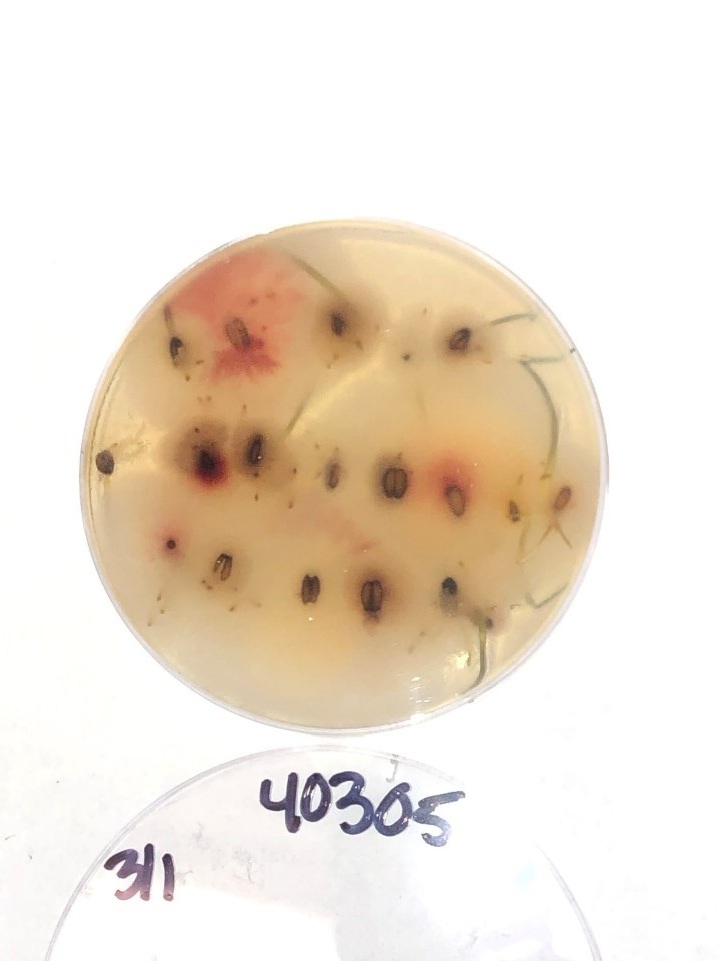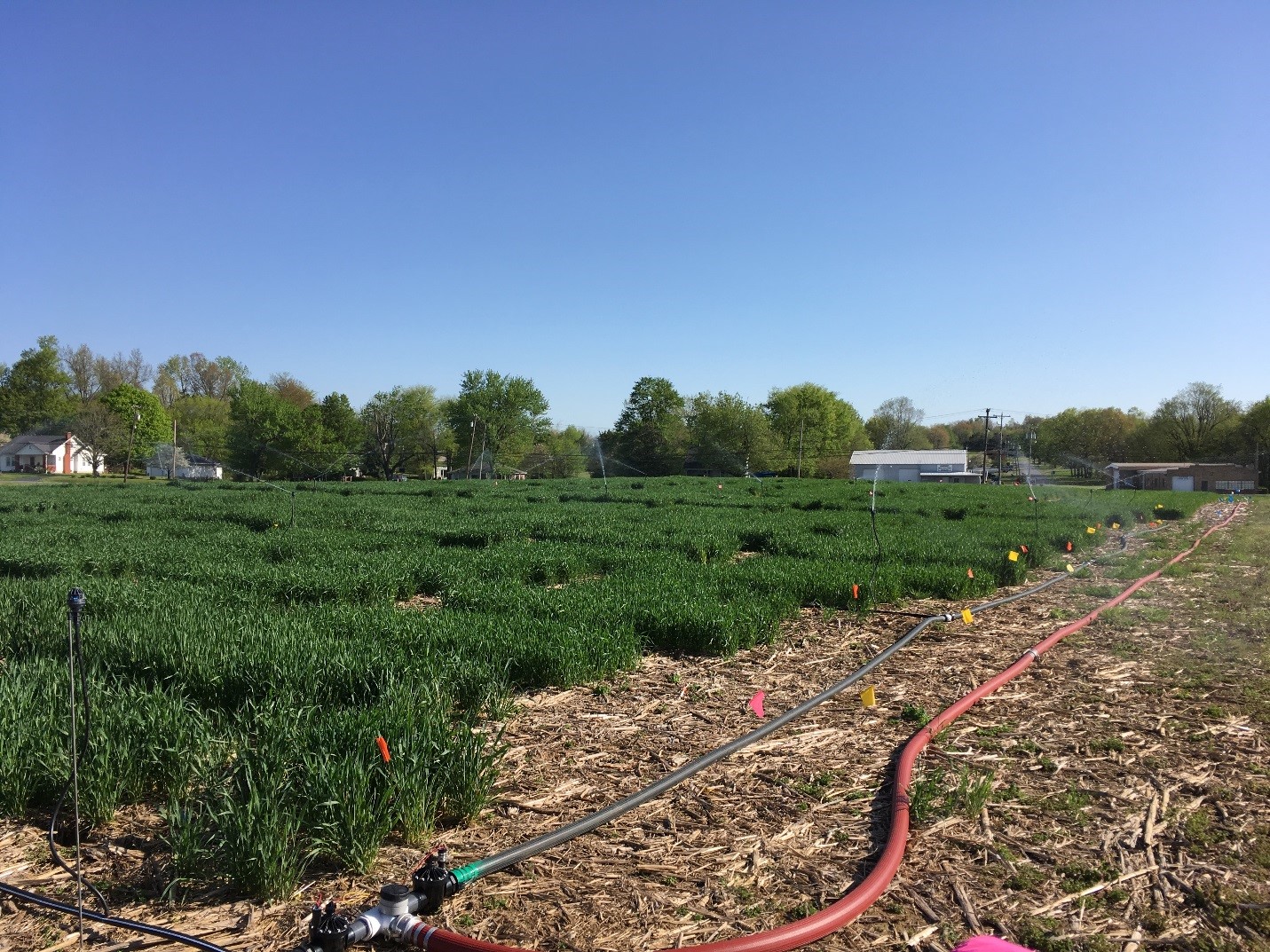Reducing Fusarium Head Blight Vomitoxin Levels through Agronomic Practices
Katherine McLachlan Rod, Carrie Knott, Carl Bradley and Jordan Shockley
Grain quality is a critically important component of profitable wheat production. In general, one of the major quality concerns for soft red winter wheat producers and millers is deoxynivalenol (DON). Deoxynivalenol is a vomitoxin that is produced by Fusarium graminearum. In Kentucky, the threat of F. graminearum infection is an annual concern.
Current agronomic recommendations to reduce DON contamination in wheat grain include planting a cultivar that is moderately resistant to Fusarium head blight (FHB) along with a fungicide application at beginning flowering (Feekes 10.5.1). The goal of this project is to examine whether additional agronomic practices can reduce DON contamination in harvested grain. These practices include harvesting at an elevated grain moisture (20 to 22% grain moisture), in-furrow phosphorus application at planting (42 lbs P2O5 acre-1), and two seeding rates (35 seed ft-2 or 56 seeds ft-2).
The objectives of this study are to determine the effect of:
Harvesting wheat at different grain moisture contents (20 to 22% versus 13 to 15% grain moisture) on DON contamination, F. graminearum infection of healthy wheat kernels, and grain yield;
In-furrow phosphorus application at planting (0 lb P2O5 acre-1 versus 42 lbs P2O5 acre-1) on the uniformity of wheat heading (Feekes 10.5) and flowering (Feekes 10.5.1 and 10.5.3), DON contamination, F. graminearum infection of healthy wheat kernels, and grain yield
Seeding rate (35 pure live seed ft-2 versus 56 pure live seed ft-2) on the uniformity of heading and flowering, DON contamination, F. graminearum infection of healthy wheat kernels, and grain yield
The profitability of these management practices
Experimental fields were established in the fall of 2016, 2017, and 2018 at the University of Kentucky’s Research and Education Center in Princeton, KY. There were two fields of ambient infection of F. graminearum and one field that was inoculated with F. graminearum-infested corn kernels. A mist irrigation system was used in the inoculated field to promote Fusarium head blight development. All fields were planted as no-till wheat into corn stubble. In each field, there were two harvest timings, an early (20 to 22% grain moisture) and a normal (13 to 15% grain moisture). Within each harvest timing there were two planting timings, an October and a November. Within the planting and harvest timing combinations there were eight treatments that were replicated five times. Treatments included two cultivars (one with moderate resistance to FHB [Pembroke 2016] and one moderately susceptible to FHB [Pioneer 26R53]), in-furrow phosphorus application (0 lb P2O5 acre-1 or 42 lbs P2O5 acre-1), and two seeding rates (35 pure live seed ft-2 or 56 pure live seed ft-2). Wheat harvested at 20 to 22% grain moisture was dried to 12.5% grain moisture with a laboratory-scale thin layer drying system (UKY’s Department of Biosystems and Agricultural Engineering).
Fingernail polished used to track heading and flowering growth stages throughout the 2019 growing season. Photo credit: Carrie Knott
Fusarium Head Blight Nursery used to promote disease development. Photo Credit: Katherine Rod
Healthy looking wheat kernels germinating in a petri dish containing selective growth media for Fusarium graminearum. The kernels with pink mycelia, fungal growth, are infected with F. graminearum. Photo credit: Curtis Bradley
A complementary laboratory study was included to determine if harvest timing, in-furrow phosphorus, or seeding rate had an effect on the percentage of healthy looking seeds infected with F. graminearum. Twenty seeds from each plot were surface sterilized prior to being plated onto PCNB agar that was used as a selective media for F. graminearum. This was replicated six times for every plot. Seeds were surface sterilized before plating. Five days after plating, seed germination and percentage of F. graminearum infected seeds were measured. If the seeds were infected with F. graminearum, the fungal growth of the mycelia would turn pink on the agar. This experiment will be continued this winter to complete the 2019 harvest data.
Preliminary analyses from the ambient F. graminearum fields in 2017 and 2018 found that grain yield was similar when wheat was harvested at 20 to 22% grain moisture (89 bu/A) and at 13 to 15% grain moisture (90 bu/A) when it was planted in October. However, when wheat was planted in November grain harvested at 20 to 22% grain moisture had significantly lower yields (72 bu/A) compared to the 13 to 15% grain moisture harvest timing (82 bu/A). Harvest timing also influenced the percentage of Fusarium damaged kernels (FDK). The early harvest timing (20 to 22% grain moisture) had less FDK (2.8%) than the traditional (13 to 15% grain moisture) harvest timing (4.8%). The early harvest timing also had a lower percentage of healthy-looking kernels infected with F. graminearum for both planting dates. In contrast, DON contamination was greater for wheat that was harvested early (20 to 22% grain moisture) than for the traditional harvest (13 to 15% grain moisture) for both the October and November planting dates. The in-furrow phosphorus treatment had no effect on grain yield, test weight, FDK, DON contamination, nor the percentage healthy-looking kernels infected with F. graminearum. The inoculated environment showed the same trends at the ambient environment at a higher magnitude. The 2019 data is still being measured and analyzed. Once all data are collected and analyzed the profitability of the additional management practices will be evaluated.
Ideally, additional agronomic practices to reduce vomitoxin levels in soft red winter wheat will be identified with this research. Within this upcoming year, data from the three years of this study will be examined and analyzed and published in a Ph.D. dissertation, peer reviewed journal articles, extension publications and at regional and national meetings.
2018 Report
Vomitoxin (deoxynivalenol; DON) levels caused by Fusarium graminearum, in soft red winter wheat are of major concern to wheat producers and millers. Current agronomic practices to reduce vomitoxin levels include planting moderately resistant wheat cultivars and fungicide applications at beginning flowering (Feekes 10.5.1 growth stage). This project is examining whether additional agronomic practices may potentially lower vomitoxin levels. These practices include harvesting wheat at higher grain moisture (20-22%), in-furrow phosphorus applications at planting (42 lbs P2O5 per acre), and different seeding rates (35 seeds ft-2 and 55 seeds ft-2).
The objectives of this study are to determine the effect of:
1) harvesting wheat at different grain moisture contents on vomitoxin levels and grain yield;
2) in-furrow phosphorus applications on the uniformity of heading and flowering, vomitoxin levels, and grain yield.
3) the profitability of these management strategies
Fusarium Head Blight nursery used to promote development of the disease and infection of wheat. Photo: Carrie Knott
Photos of wheat plots were taken every day for 14 days to determine each plot’s heading and flowering uniformity. Photo: Katherine Rod
Experimental fields were established in the fall of 2016 and 2017 at the University of Kentucky’s Research and Education Center in Princeton, KY. There was one field of ambient infection of F. graminearium and one field that was inoculated with F. graminearium infested scabby corn. The inoculated field was irrigated to promote Fusarium Head Blight (FHB) development and infection in the spring. Each of these fields had a normal (mid-October) and late (mid-November) planting date and an early (20-22% grain moisture) and normal (13-15% grain moisture) harvest timing. Within each of the planting and harvest timings there was eight treatments consisting of two cultivars (moderately susceptible to FHB [Pioneer 26R53] and moderately resistant to FHB [Pembroke 2016]), and two in-furrow phosphorus applications (0 lbs P2O5 per acre and 42 lbs P2O5 per acre), each planted at two seeding rates (35 seeds ft-2 and 55 seeds ft-2 ). Wheat harvested at 20-22% grain moisture were placed into drying columns owned by UK’s Biosystems and Agricultural Engineering, where the grain was dried to 12.5% moisture. Grain samples were also evaluated for DON concentration.
Normal looking wheat kernels germinating in a petri dish containing selective growth media for Fusarium graminearum. The kernels with bright pink mycelia, fungal growth, are infected with F. graminearum. Photo: Katherine Rod
In preliminary data analyses of the past two years, grain yield in 2018 was consistently greater for the wheat that was planted in October and harvested at 20-22% grain moisture. In fact, there was an 11 bushel per acre increase in yield when grain was harvested at 20-22% grain moisture rather than 13-15% grain moisture: 86 bushel per acre compared to 75 bushel per acre. However, in 2017, consistent differences in yield due to grain moisture at harvest were not detected.
In preliminary analyses of the 2017 data, the presence of Fusarium in the harvested kernels, as determined by percent Fusarium Damaged Kernels (FDK), was less (7% FDK) for the early harvest (20-22% grain moisture) than the normal harvest (13-15% grain moisture) which had 11% FDK. Additionally, the percentage of normal looking seeds that were infected with F. graminearum were lower when grain was harvested at 20-22% grain moisture. However, DON concentrations were lower for the harvest that occurred at 13-15% grain moisture. Data from 2018 are still being measured.
For the in-furrow phosphorus applications, the preliminary data from 2017 indicate that neither FDK nor DON concentration of the grain did not differ regardless of in-furrow phosphorus treatment. However, the percent of normal looking kernels that were infected with F. graminearum was reduced by 1% when in-furrow phosphorus was present (42 lbs P2O5 per acre). Data for the 2018 season will be measured in the winter of 2018.
Ideally, additional agronomic practices to reduce vomitoxin levels in winter wheat will be identified with this research. One more year, the 2019 season, will be examined to help us determine the consistency of the results we have found thus far and to determine the profitability of any additional agronomic practices to reduce vomitoxin levels.






